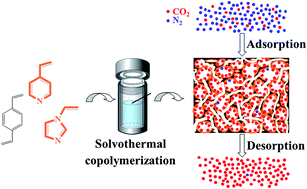Solvothermal synthesis of hierarchically nanoporous organic polymers with tunable nitrogen functionality for highly selective capture of CO2
Abstract
A series of porous organic polymers (POPs) with tunable nitrogen functionality and hierarchical porosity were successfully synthesized from the one-step copolymerization of divinylbenzene with 4-vinylpyridine or 1-vinylimidazolate under solvothermal conditions. The FTIR results, XPS spectra, and elemental analysis validated the incorporation of different kinds and contents of nitrogen species into the framework-synthesized POPs. The N2 adsorption isotherms at −196 °C and SEM and TEM images revealed that the synthesized POPs have large surface areas and abundant meso–macropores. The CO2 and N2 adsorption experiments demonstrated that the synthesized POPs have competitive capacity for CO2 at a relatively low pressure of 0.15 bar (0.64–1.47 mmol g−1 at 0 °C and 0.49–0.87 mmol g−1 at 25 °C) and exceptionally high IAST selectivity for CO2/N2 (0.15/0.85) at 1 bar (74.9–154.8 at 0 °C and 91.8–224.5 at 25 °C). The CO2/N2 selectivity is superior to that of most other reported physical adsorbents. This work provides a facile approach to the targeted synthesis of nitrogen-functionalized POPs with potential applications in the selective capture of CO2 from flue gas.

- This article is part of the themed collection: 2016 Journal of Materials Chemistry A HOT Papers

 Please wait while we load your content...
Please wait while we load your content...